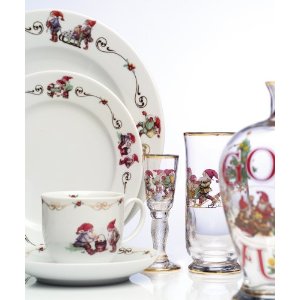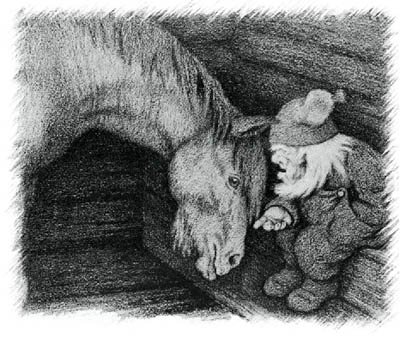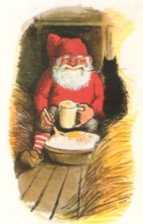|
Nisse or Nisser in ScandinaviaOne of the old spirits has refused to give up Jul of the ancient kind. After the proliferation of candles, the next surest sign of Christmas in Denmark or Christmas in Scandinavia for that matter, is the appearance of nisser. He can be described but is somewhat more difficult to define. This mythical figure is always a he. And he is short, like one of the ancient dwarfs, but is usually less troublesome than those dwarfs who connived with and against the gods of legend. They wear homespun clothes and a red cap; they sport long gray beards. Like Santa they are very much part of the Christmas season, and like Santa they are plagued by dozens of impostors who show up everywhere. In department stores, on street corners, in store windows, on television - purporting to be the genuine article.
Like old Saint Nick, he is very clever about getting around without actually being seen. And like Santa, he expects a snack on Christmas Eve. But beyond these token similarities, nisser and Santa Claus are not really much alike. He doesn't really do much, and he most certainly doesn't go in for anything as strenuous as delivering gifts. He is rather more gruff than jolly, and he much prefer an attic or a hayloft to a sooty chimney stack. Scandinavian children, of course, love their nisser, but nisser have no affinity for children over adults. If Santa is not remembered with a plate of cookies on Christmas Eve, he is not really peeved, but nisser when not fed his porridge on Christmas Eve can be cantankerous, if not downright dangerous. Santa's good behavior can, of course, be taken for granted; he is, after all, a saint. Everyone in Scandinavia knows that a nisse is no saint. While everyone agrees on a nisse's lack of saintliness, even experts cannot agree on what exactly he is. Some consider him a sprite, that is, an elf, or a fairy, or a goblin. In the countryside, he is thought of as a spirit of one's forefathers who, during Jul comes around to check that the family farm or the ancestral home is being cared for in the proper manner. Scholars insist that nisser are related to the devil. The word nis is identical to Niels, and in Denmark the devil is referred to as Old Niels much as the devil in England is called Old Nick.

Although Nisser are known to hang around with cats who, nonbelievers insist, actually consume that Christmas porridge, no self-respecting Scandinavian really considers a Nisse a devil. It is true he is mischievious, but is certainly not downright evil. Now there are a few hard facts about nisser: they are small, they are mishievious; they are old enough to be acquainted with Odin and the other gods of Valhalla, and that, of course, is very old. Nisser have always hung around during Jul. And there is no reason to think that won't continue in the future. It is well known that the Nisser prefer the dark, which is one reason they may appear only during the long nights of December. It has been suggested that he might be a little less elusive if there were not so many candles putting out so much light. It has also been suggested that there might be fewer candles burning if there were not so many nisser lurking. It is a bit of a standoff, and one that is not likely to be resolved quickly, for Scandinavians like Jul the way it is. They like their nisser, of course, but they also like their candles. Both appear simultaneously around Advent, which, appropriately means "the coming." The coming of course refers to the coming of Christ. But in Scandinavia, it also points to the coming of Jul and everything that implies.
Nisse - the Scandinavian symbol of Christmas
|


